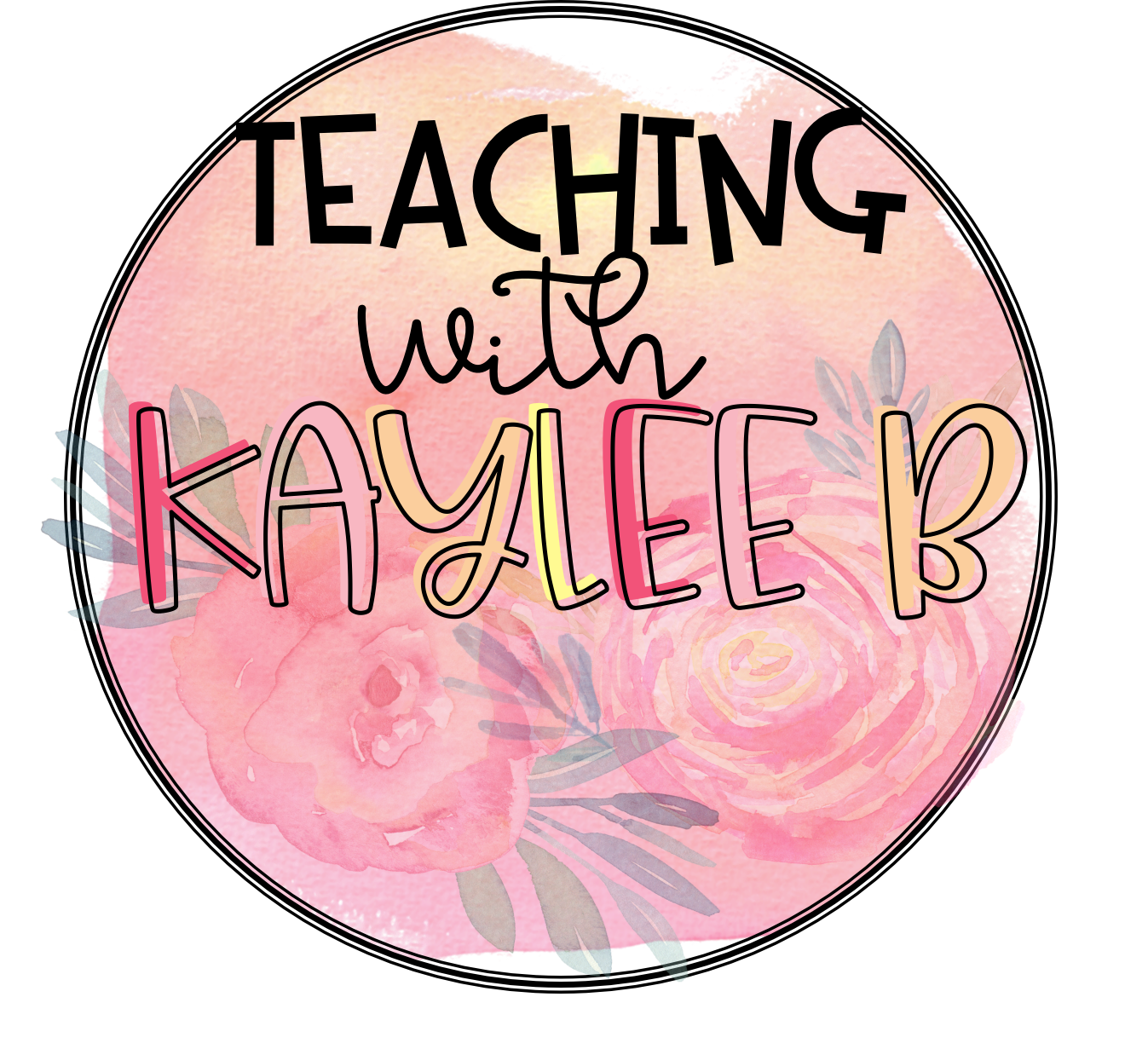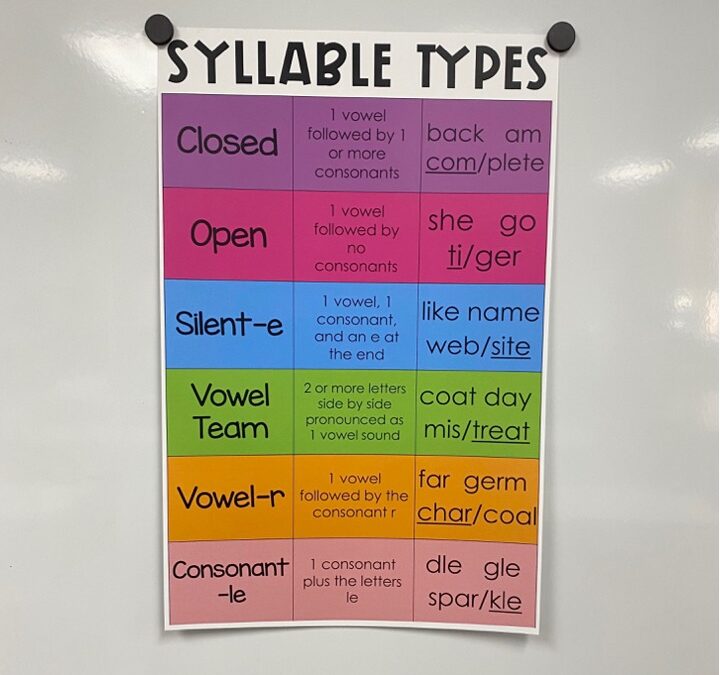One of my favorite things to teach my 2nd grade students is syllable types. Once students know these, it opens up a new world for them. They can now know how to decode and spell multisyllabic words. At first, teaching all six syllable types can seem like a daunting task, but by using a types of syllables anchor chart it makes the process much easier for teachers and students.
As students begin to learn to read and write, they need to develop a solid understanding of the different syllable types. Like I said before, there are six different syllable types that students need to learn in order to decode words effectively: closed, open, silent-e, vowel team, vowel-r, and consonant-le. In this blog post, we will explore some effective strategies that teachers can use to teach the six syllable types to 1st and 2nd grade students.
But let’s first make sure that you as the teacher understand the six syllable types.
Six Syllable Types
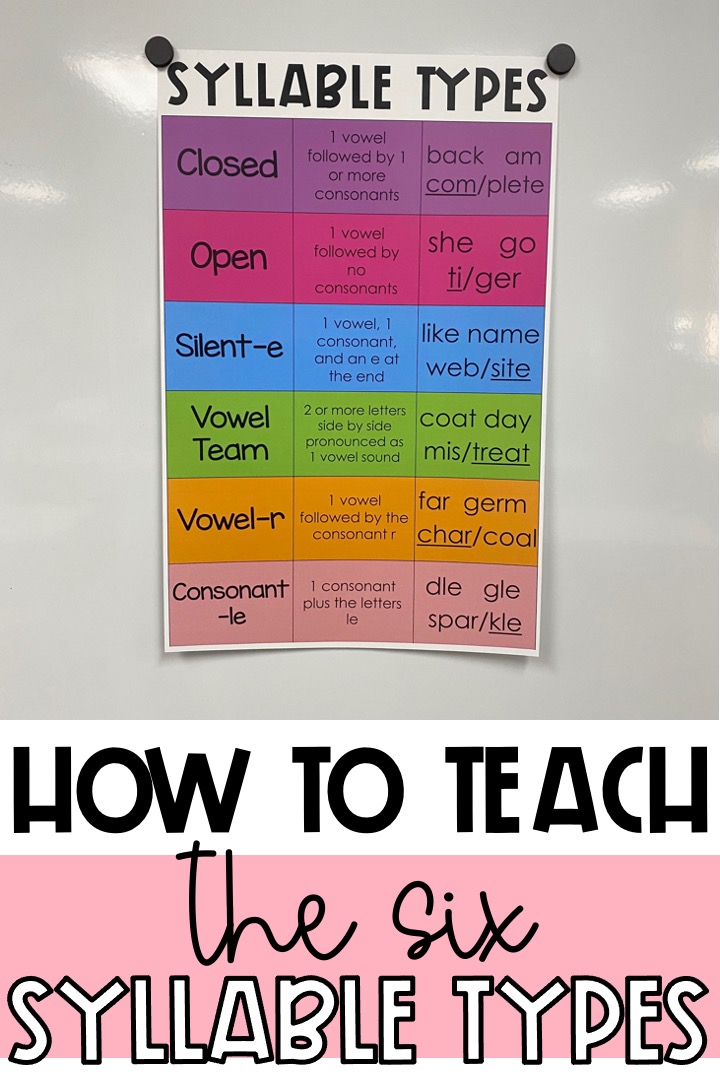
Closed Syllables: If a syllable has one vowel followed by one or more consonants, then it is a closed syllable. Closed syllables have a short vowel sound. Many words in the English language have closed syllables. Here are some one syllable word examples: back, glass, still, got, fun. Here are some 2 syllable word examples: tan/trum, sim/ple, com/plex
Open Syllables: These are syllables that have one vowel followed by no consonants. The vowel sound is long. A lot of high frequency words have open syllables. Think of words like: go, he, she, hi. Here are some two syllable words with open syllables: ti/ger, ta/ble, so/lo, re/mote.
Silent-e Syllables: With this syllable type, you have one vowel, then one consonant, and then an e at the end. The vowel sound is long. Here are some one syllable examples: cave, like, cube, bone. Here are some two syllable word examples: ex/treme, home/work, web/site
Vowel Team Syllables: These are syllables with 2 or more letters side by side that is pronounced as one vowel sound. Vowel sounds can vary with the vowel team syllable. Think of the words eagle and bread. The vowel team “ea” in eagle says the long e sound while the “ea” in bread makes the short vowel sound. Here are some one syllable word examples: field, pail, out, snow, boil, hay. Here are some two syllable word examples: mis/treat, char/coal, can/teen.
Vowel-r Syllables: With this syllable type, there is a vowel followed by the consonant r. The r controls the vowel sound. Here are some one syllable word examples: car, germ, corn, blur, first. Here are some two syllable word examples: con/cert, car/pool, bur/den.
Consonant-le Syllables: If a syllable has a consonant that is followed by the letters “le” then it is a consonant-le syllable. These syllables are never one syllable words, they will also be at the end of a word. The vowel sound is the schwa sound. Here are some consonant-le syllable examples: sprin/kle, peb/ble, pur/ple.
There are a lot of technical things when it comes to these definitions of each syllable type. That is why I like to use a types of syllables anchor chart when it comes to teaching syllable types to my students. Let’s get into how I teach my students syllable types that will help them with their spelling, decoding skills, and ultimately their reading fluency and comprehension.
Types of Syllables Anchor Chart
Here’s a lesson plan you can use as a guide when you are teaching your students about syllable types.
Review Prior Knowledge of Vowels: Since syllables have so much to do with vowels, you want to make sure that your students know what letters are vowels. I have the alphabet displayed above my front whiteboard. I put a small pink sticky note under all of the vowel letters. You will also want to review what short vowel sounds are and what long vowel sounds are. Then you can explain that by knowing the 6 syllable types, it will help you know what vowel sound to use as you are reading words.
Introduce the six syllable types: Start by introducing each of the six syllable types to your students. Provide them with examples of each type and explain the patterns that they should look for in words. Use my Types of Syllables Anchor Chart to do this. This gives the definitions to each syllable type plus examples of one syllable words and two syllable words. I also have syllable posters for each individual syllable type that I display as I teach. These show the vowel sound for each syllable type. You can even get creative and make up a hand signal for students to do when they come to a certain type of syllable. For example, you could do a closed fist for a closed syllable. Adding in movement will help students remember the syllable types better. Find my Types of Syllables Anchor Chart here.
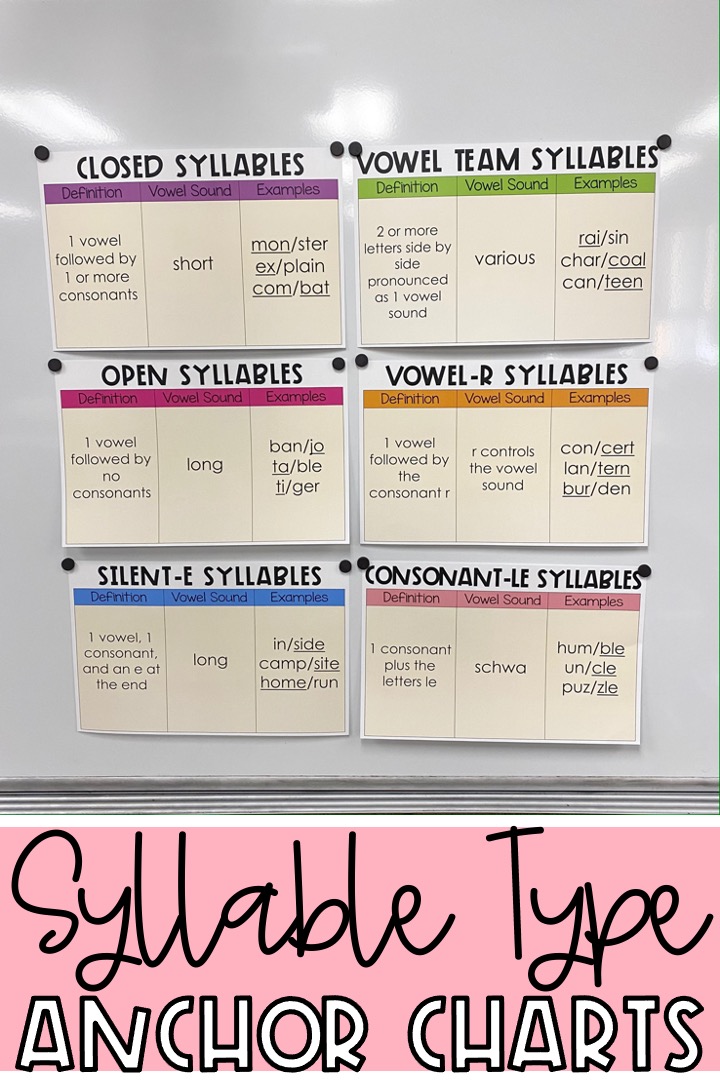
Practice Splitting 2 Syllable Words: Now you will want to teach your students how to split 2 syllable words. To do this write up a 2 syllable word on the board. Then have students help you find the vowels/vowel sounds in the word. Underline these. If there are two consonants in between the vowels, then you split it down the middle of the two consonants.
If there are 3 consonants then look for digraphs and blends. We want to keep those together. For example, look at the word contrast. “ntr” are the consonants in between the vowels. “Tr” is a blend and we want to keep those together. So we would split the word like this: con/trast.
When there is only one vowel in between the consonants, tell students they need to check if there is an open syllable. Take the word “robin.” It is just a “b” in the middle of the two vowels. So you have to check if you should split it before the b or after the b. If you split it before the b, it would look like this, ro/bin. The first syllable has one vowel, followed by no consonants making it open and have a long vowel sound. Try reading it with the long vowel sound. It doesn’t sound like a real word. So then you try splitting it after the b. The word would look like this, rob/in. It makes that first syllable closed and it would have a short vowel sound. Try reading it like that and it sounds like a real word! Repeat this with other words like tiger or remote.
Point out to students that if the word has a prefix, then they split the word after the prefix. Let’s look at the word “retract” for an example. If you underline the vowels, there are two consonants in the middle. Usually you would split it down the middle, but because there is a prefix, you split the word like this, “re/tract.” Learn more about how I teach my students prefixes and suffixes here in this blog post: How to Teach Prefixes and suffixes to 2nd graders.
Then give students practice splitting words in syllables. I give my students worksheets with a grid full of 2 syllable words. I project it up on the whiteboard and we work through it together. Day 1 we do it together. Day 2 we do most of it together but then I have my students do the last few words by themselves. Then we check their work. Day 3 we do half of it together and students do half of it by themselves. Day 4 students work with a partner and then on Day 5 they split all the words by themselves. Have them practice reading the words after they have split the words. Find the worksheets I use here.
Practice syllable types with word sorts: Word sorts are a great way for students to practice identifying the different syllable types. I have students split 2 syllable words and then sort the syllables according to their types. Again, I have worksheets for this. It has a grid where students can easily sort the words. We practice together and then as the days go on, they do more and more by themselves. Reference the Types of Syllable Anchor Chart when needed. Focus on the vowels and patterns. As you are doing these activities with your students, you can follow the same pattern I shared with the days up above. Find these syllable sort worksheets here.
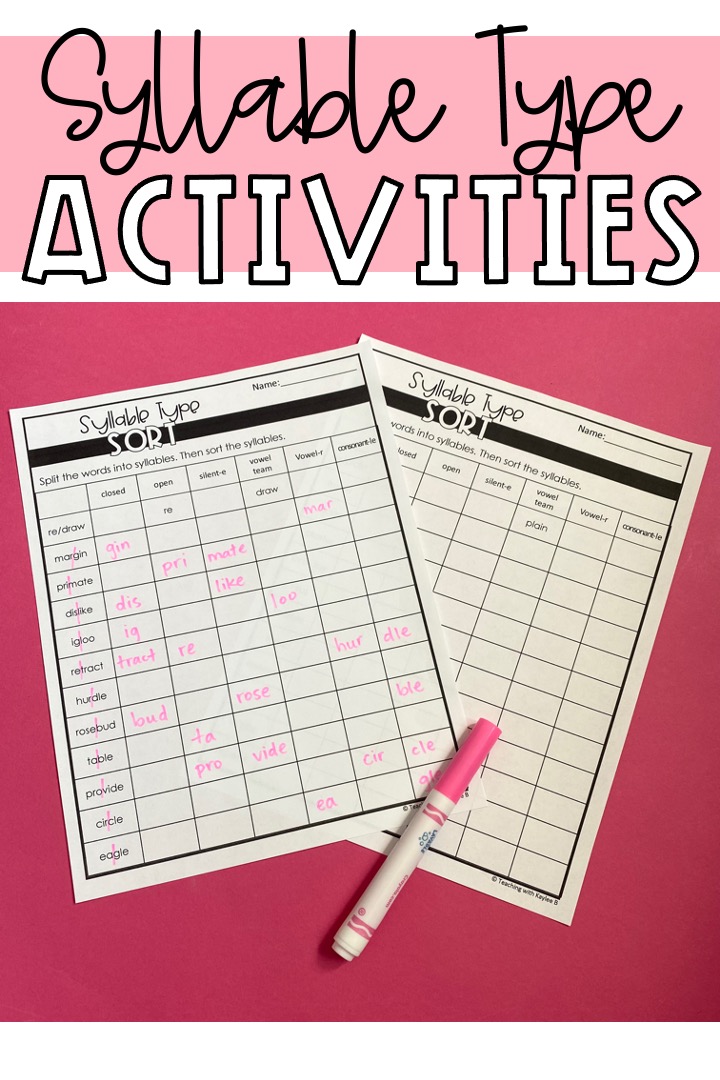
Make 2 syllable words: This is one of my favorite activities to help my students learn 2 syllable words. I split up 2 syllable words and randomize all the first syllables and all the second syllables. Then students have to match up the first syllable to the correct 2 syllable and then write the word. I love how this activity gets students reading the syllables. I have worksheets that help me do this activity easily. I follow the same pattern above where I start doing the whole worksheet with my students and then over the days let them do more and more by themselves.
I also have students do a similar activity like this as a center activity. The syllables are on cards and students have to match them up to make 2 syllable words. Then they sort the syllables in types. I have header cards with the 6 syllable types. Find these worksheets and sorting activity here.
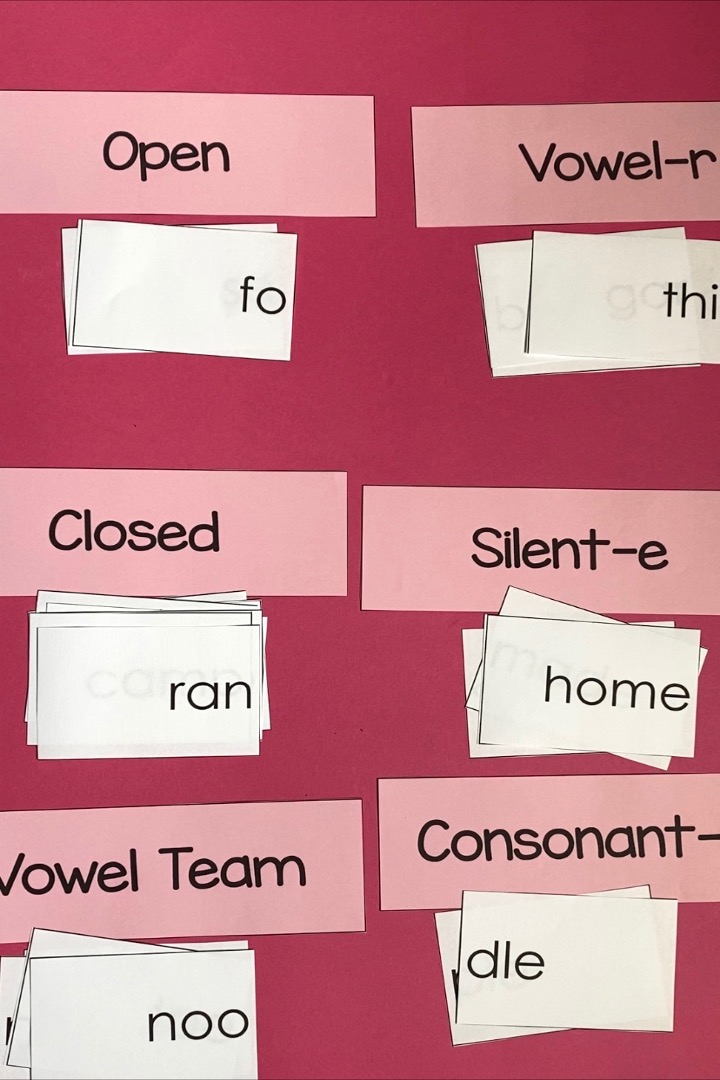
Teach syllable types in context: The reason we teach syllable types is so students can spell and decode words. We want students to be able to decode words so they can build their fluency and comprehension. That is why we need to teach syllable types in context. Read books with your students that contain words with different syllable types. Choose books that contain a variety of syllable types and have students identify them as they read.
I also teach syllable types in context by using fill in the blank worksheets. The worksheet has a word bank full of 2 syllable words. Then there are sentences where students have to use the context to know which 2 syllable word should go where. This is great reading practice for students. Find these worksheets here.
Have students flip the page over and practice spelling two syllable words on the back. Tell students a 2 syllable word. Then they clap it out and sound out the sounds to know what to write. After practicing a few words, give them a sentence with a couple 2 syllable words in it. Then help students check their spelling on the sentence. Putting things into context helps students see the “why” in what they are learning.
Teaching the six syllable types is an important part of developing strong reading and writing skills. I hope that you will use these strategies to effectively teach the six syllable types to your 1st or 2nd grade students. By doing so, it will help them become confident and proficient readers and writers.
